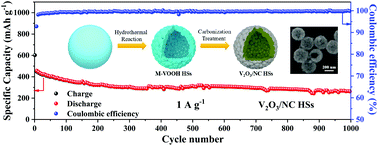Melamine-assisted synthesis of porous V2O3/N-doped carbon hollow nanospheres for efficient sodium-ion storage†
Abstract
Vanadium-based oxides with relatively high theoretical capacity have been regarded as promising electrode materials for boosting energy conversion and storage. However, their poor electrical conductivity usually leads to unsatisfied performance and poor cycling stability. Herein, uniform V2O3/N-doped carbon hollow nanospheres (V2O3/NC HSs) with mesoporous structures were successfully synthesized through a melamine-assisted simple hydrothermal reaction and carbonization treatment. We demonstrated that the introduction of melamine played an essential role in the construction of V2O3/NC HSs. Benefitting from the special mesoporous structure and large specific surface area, the as-obtained sample exhibited enhanced conductivity and structural stability. As a proof of concept, well-defined V2O3/NC HSs exhibited excellent cycling stability and rate performance for sodium-ion batteries, and achieved a discharge capacity of 263.8 mA h g−1 at a current density of 1.0 A g−1 after 1000 cycles, one of the best performances of V-based compounds. The enhanced performance could be attributed to the synergistic effect of the hollow structure and surface carbon coating. The present work describes the design of the morphology and structure of vanadium-based oxides for energy storage devices.



 Please wait while we load your content...
Please wait while we load your content...